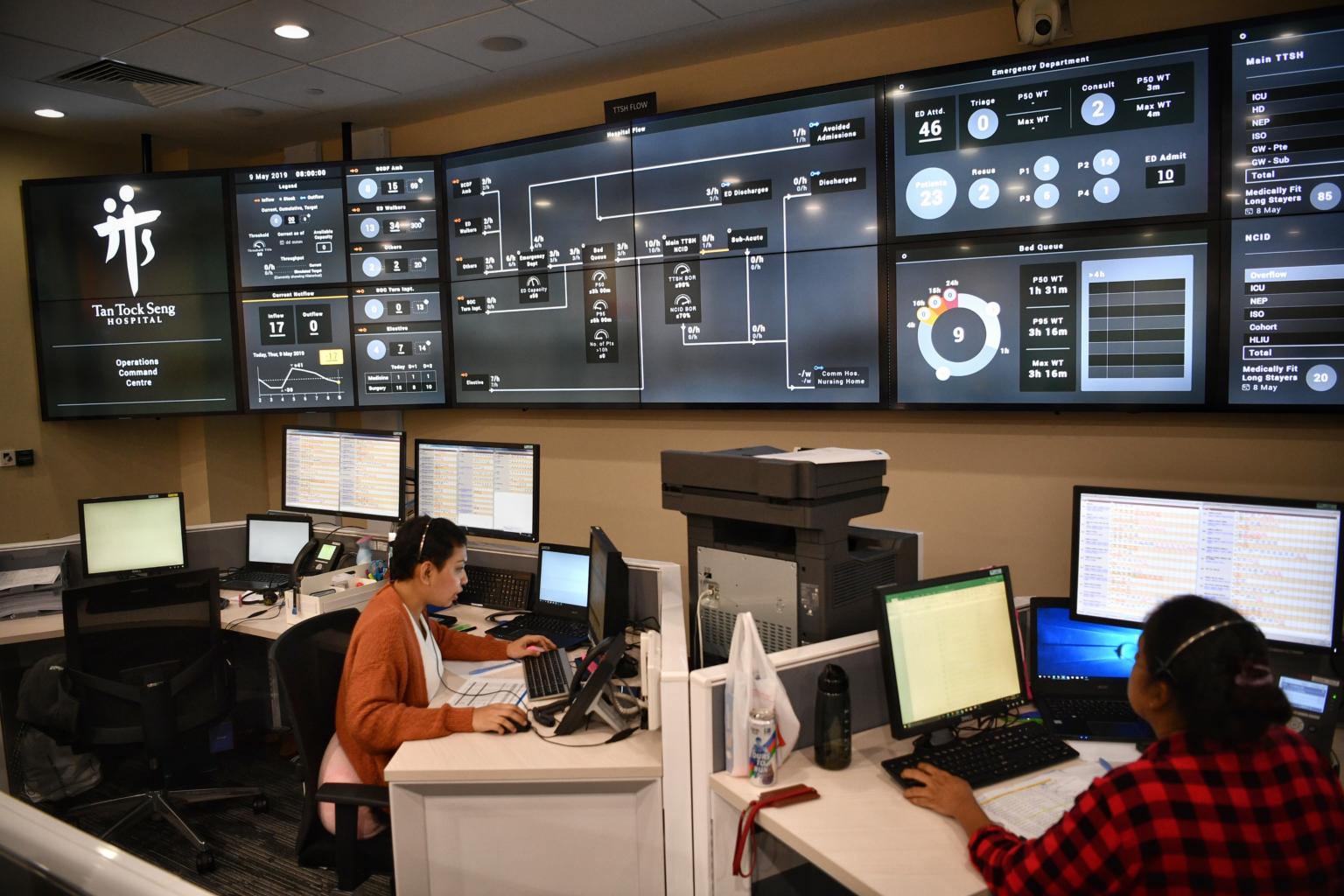Healthcare workers now have centre for innovation to turn ideas into prototypes
Sign up now: Get ST's newsletters delivered to your inbox

A view of the C3 Operations Command Centre, housed in the Ng Teng Fong Centre for Healthcare Innovation.
ST PHOTO: ARIFFIN JAMAR
Follow topic:
SINGAPORE - At Tan Tock Seng Hospital (TTSH), a prototype of a geriatric chair is currently being trialled for physical rehabilitation.
The chair, which also transforms into a makeshift bed for caregivers or a bench for visitors, was developed in collaboration with Nanyang Polytechnic and conceptualised at the Ng Teng Fong Centre for Healthcare Innovation (CHI).
And it was a staff member who came up with the idea.
The centre, located opposite TTSH in Novena, promotes innovation across the public healthcare sector here.
It aims to transform public healthcare operations, support healthcare workers who want to turn their ideas into working prototypes and also give them more access to information and knowledge.
The centre was officially opened on Thursday (May 9) by Health Minister Gan Kim Yong.
"With rising healthcare demands from an ageing population and slowing local workforce growth, we need to innovate and transform our system to overcome constraints and seek new solutions," said Mr Gan.
"I hope to see CHI play a pivotal role in promoting innovation in healthcare."
The centre stands beside the National Centre for Infectious Diseases (NCID), which started operations in November 2018 and will be fully operational by the end of May. The two facilities together cost $940 million to build.
The CHI building also houses TTSH's new state-of-the-art command, control and communications (C3) system, jointly developed by TTSH and the Integrated Health Information Systems (IHiS), the central IT agency for the public healthcare system.
The C3 centre, which will go live progressively from the third quarter of this year, is similar to an airport control tower and provides operators with real-time visualisations of the hospital's ground operations, said the hospital's chief operating officer, Dr Jamie Lim.
"Our approach to bed management has moved away from inventory management, which just looks at the number of beds we have available, to a patient flow concept.
"What this means is that we are now following patients from the point of admission to discharge and optimising how we assign beds to them," added Dr Lim.
Patients who enter the hospital's emergency department will be tracked and sorted according to the severity of their condition. Those with more serious conditions will be given priority.
The system will also use artificial intelligence to assign patients to the most optimal bed and ward according to their needs, predict potential choke points and keep track of beds that are currently occupied by patients scheduled to be discharged.
Mr Bruce Liang, chief information officer at the Health Ministry and chief executive of IHiS, said: "We hope to scale C3 to other public healthcare institutions from 2020.
"When scaled at a national level, C3 will enable enhanced load balancing of our healthcare resources across the public hospitals to better serve our population, as well as allow for better coordination during a national crisis."
He added that when the system is rolled out to other hospitals, it would be possible for ambulances to coordinate with the hospitals and send patients to an emergency department with more available capacity instead of one experiencing congestion.
The new CHI facility also features a "maker space" on the first floor called the CHI Living Lab (Chill).
Healthcare professionals who come up with ideas in the course of their work can consult designers at Chill who use various tools like 3D-printers to help turn concepts into working products.
Ms Lynette Ong, director for TTSH's Kaizen Office (named for the Japanese philosophy of continuous improvement), gave the geriatric chair as an example of a concept that came from a staff member of the hospital's rehabilitation ward.
A new open knowledge repository called the CHI Learning and Development system, to be housed at CHI, is also in the works.
Associate Professor Wong Hon Tym, CHI's clinical director, said: "The system will allow Singapore's healthcare facilities to contribute their collective experience, projects, lessons and best practices to a searchable database.
"We are also going to form what we call online communities of practice - basically chat groups for people who are dealing with the same challenges in different areas of Singapore who will be able to connect and learn from each other."
Prof Wong said his team has curated about 300 projects for the repository so far. They are aiming to gather a total of 500 by the end of the year, when an online portal for the system is set to be launched.
The topics range from eldercare and chronic wound management to population health and patient engagement.

